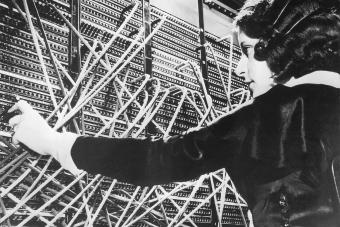
It's the twenties again and we're taking a look back at what life was like in the decade that gave roaring a whole new meaning. In honor of the decade's 100-year anniversary, we're unpacking what family life was like in the 1920s, from the regional differences in urban and rural spaces to how people spent their downtime.
Traditional Family Practices in the 1920s
The U.S. Census Bureau statistics Historical Statistics from the Colonial Era to the 1970s report explore what American families looked like throughout history. In the 1920s, marriage was still a goal and priority for most, but smaller household sizes began to take shape as men and women sought to have fewer children and embrace the new possibilities of the decade.
Family Leisure Activities in the 1920s
At home, families with a battery-powered radio could listen to radio shows. These early radios often only had one headphone instead of a speaker, so kids would fight over who got to listen to which shows.
Gender Roles in the 1920s
Although many aspects of the 1920s lifestyle were changing, men and women still mostly held the traditional roles of decades passed. Men typically worked long hours in professions involving hard labor. Despite the image of 1920s women as independent and rebellious, a 1920s mother still took on caring for children and taking care of household tasks as her primary job. Each person within a household was expected to uphold male or female roles and saw the value in these tasks as a means to meet all the needs of the family as a whole.
Marriage in the 1920s
According to the Census Bureau's report, nearly two-thirds of all people over age 14 were married while only around 250,000 out of 37 million people were divorced in 1920. The average age for a first marriage in 1920 was 24 for men and 21 for women. Although marriage rates were high for most people, by 1920, Black women were more likely to be married than white women. In general, men and women wanted to be married — whether because of traditional standards or the benefits it afforded.
Attitudes Towards Birth Control in the 1920s
Thanks to advances in birth control methods, like the legalization of condoms and the availability of the diaphragm, couples had more control over family planning. An average household during this decade consisted of about four people, according to the Census Bureau's report.
Child Rearing Practices in the 1920s
Parents started to shift their thinking from the traditional view of the family as a hierarchy to a more emotional approach. Affectionate views of immediate family members meant husbands and wives saw each other as friends, while still upholding traditional authoritarian gender norms, and often viewed their kids as friends too.
How Families of Color Were Structured in the 1920s

For many families of color, cultural identity and racial pride were important values as they sought to gain better treatment in systems that actively denied them equality and equity. Because of the job opportunities available to them (in terms of dangerous work conditions and unequal wages) and the lack of affordable housing access, minority families were composed of more than just a nuclear unit with many extended family members living together.
Rural Family Life in the 1920s
Up until 1920, the majority of white Americans lived in rural areas. However, according to Census.gov, by 1920 more than half of Americans were living in cities and towns. While there were now technically more urban dwellers, nearly half of all families still lived on farms. In contrast, while many African American families did move north during this decade, they were still more likely to reside in rural areas. The same is true for people identified as being from "other races" by the U.S. Census Bureau.

Rural families embraced farm life amid the changing national landscape. Because there was so much work to do all the time, every member of a farm family worked on the farm. Men mostly worked in the fields or on building and repairing the homestead and equipment.
Although industry was making strides in the invention and mass production of machines, this movement had not yet reached small farms. Since most farmers were still completing all work by hand, neighbors helped each other with large harvests to get the work done before seasons changed.
Wives and mothers still tended to household chores like sewing, cooking, canning, and caring for babies. But, they also helped with work in the fields when needed. Farm women made sure everyone, especially the farm-laboring men, were taken care of, as a means to keep the family prepared for long days.
Rural Childhoods
Children on farms in this decade were called upon to help with the workload as soon as they were able. Chores like feeding animals, gathering eggs, or chopping wood were common for younger children. Once the chores were done for the day, kids would walk or ride a horse up to several miles to reach the closest school. Children spent about eight years in primary school, with summers off, memorizing poems and playing games. Older children could attend high school in the nearest town if there was a high school and they hey could get there.
Rural Leisure Activities
Life in 1920s rural America wasn't all work, although that is how people spent most of their time. Families enjoyed school presentations or end-of-the-year picnics where they could gather with neighbors. Churches held gatherings, potluck dinners, and ice cream socials as a way to bring people together for fun. Trips to town were also a favorite pastime for families. In the summer when they had goods to sell, families could visit the town and watch movies projected onto the side of a building.
Other popular town events were horse races or the Chautauqua, a tent with lectures, plays, and music open to the public. In the country, kids could go swimming in nearby creeks and streams or go fishing.
Related: 1920s Children's Fashion Facts: A Shift Towards Comfort & Convenience
Urban Family Life in the 1920s
Thanks to electricity and indoor plumbing, household chores were made easier for those who could afford vacuum cleaners and other domestic inventions. Lights also made it possible for people to stay up later in cities and partake in more activities.
Common Urban Employment

Town and city workforces took on a more diverse look in the 1920s. At this time, there was a large-scale relocation of Black families from the rural South to the urban North, because of their need to find better jobs; although they still only had access to cheap labor jobs.
In 1890, about 10% of African Americans lived in the North, but by 1930 about 20% lived there. Black women whose husbands worked outside the home were twice as likely as white women in the same scenario to work outside the home. These women were also more likely to be the head of a household, not because of low marriage rates, but because Black men had higher mortality rates due to occupational hazards and other factors than white men.
The prevalence of women in the workforce rose 25% during this time because many women had taken jobs outside the home during WWI. Millions of women in cities and towns worked in new jobs as stenographers, secretaries, telephone operators, store clerks, and factory workers. Roughly 15% of white women whose husbands worked outside the home also worked outside the home in the 1920s.
Urban Childhoods

City kids worked in jobs outside the home like selling newspapers, shining shoes, or in factories to help support their family. When they weren't working or helping their parents, all kids ages 8-14 were required to attend school for part of each year. City schools were separated into school districts with public schools funded by state and local taxes. This led to inequality in educational standards based on the area where a child lived. Wealthy school districts had access to well-trained teachers and better books, while poor school districts had few resources.
Although enrollment in schools was on the rise during this decade, these stark differences in educational supplies and resources were evident in the fact that about 15% of white people older than 14, native or foreign-born, were illiterate in 1920, while 23% of Blacks and people of other races were illiterate.
There weren't any national child labor laws until the Fair Labor Standards Act of 1938 established a minimum working-age of 16 years old.
Urban Leisure Activities
City families had better access to real movie theaters often called "picture palaces" because they were so large and extravagant. Theaters included extras like a children's nursery, lounges, and even dance floors to entice people to visit regularly. By the end of the 1920s, about three-fourths of Americans visited movie theaters on a weekly basis.
The 1920s was an Explorative Time for Families
While employment opportunities, family structures, and leisure time in the 1920s may look different than those of today, people still worked together to support their family units and build thriving communities. From going to the movies to cooking family dinners, there are many ways that your family may mirror those from over a hundred years ago.







